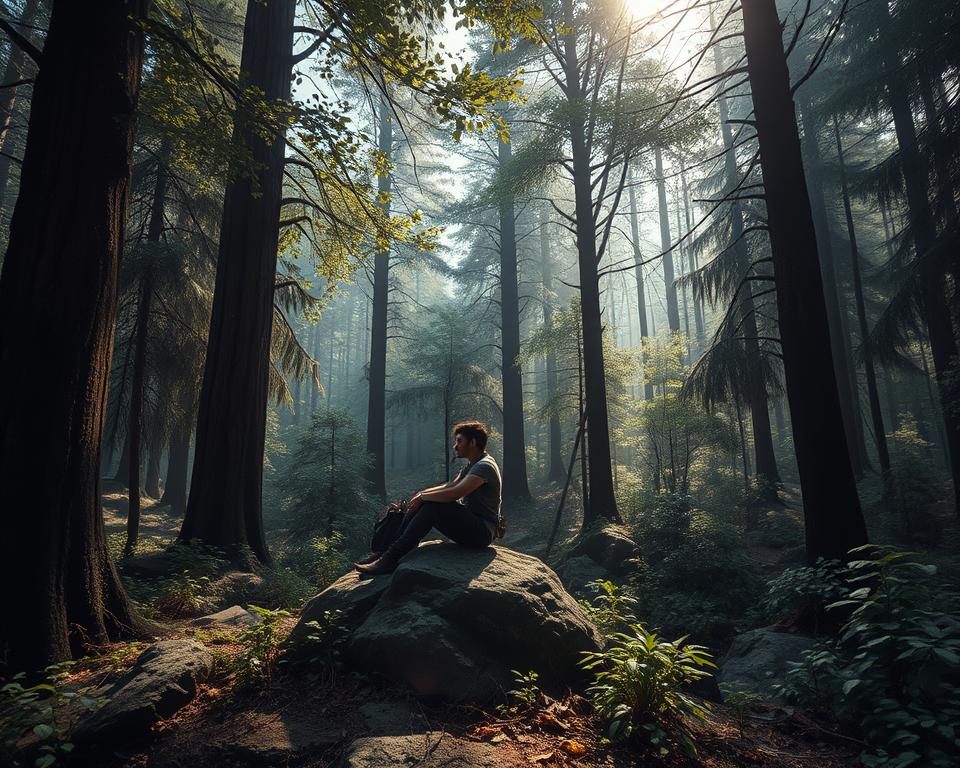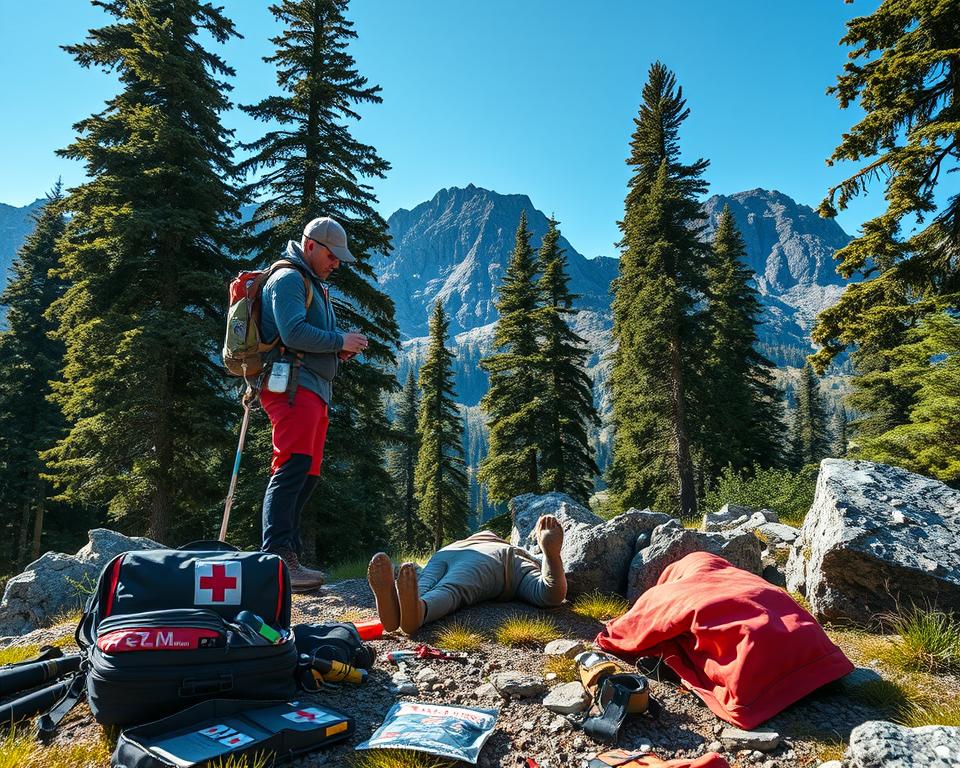Adventure awaits in places like Yosemite National Park, with its 800 miles of paths. Yet, stunning views can come with dangers. Every year, about 250 emergencies happen in Yosemite. This shows why being prepared is key.
If you love hiking or are new to it, knowing how to manage surprises is essential. This guide covers outdoor safety and crisis skills. It aims to prepare you for emergencies.
Packing smart is more than just bringing a headlamp and water. You need to know your trail, tell someone your plans, and have an emergency kit. Keeping yourself fit is also vital. This helps avoid issues on tough terrains. For more safety tips, click here.
Preparation Before You Hike
Before you start your hike, making sure you’re well-prepared is key. Whether it’s for a day or longer, good prep improves safety and fun.
Research Your Route
Learning about your hiking trail is important. Look at maps and updates to get to know the trail’s features and conditions. Use apps like AllTrails to plan your hike and get updates. Remember, your phone might not work in many parks, so knowing your route is crucial.
Inform Someone of Your Plans
Tell someone your hiking details like where you’re starting, when you’ll return, and your path. This step is crucial for your safety. It means someone knows where to search for you if needed. Hiking with a friend also makes things safer.
Essential Items for Your Emergency Kit
Your emergency kit is vital for tough situations. It should have:
- First aid supplies
- Navigation tools
- Extra food and water
- A multi-tool
- Fire starter
- Means for signaling distress, such as a 120 dB siren alarm
Also, wear thick socks and good boots to protect your feet. Pack extra food and water to stay energized and hydrated.
Basic First Aid Knowledge
Knowing first aid is a must for hikers. American Red Cross courses teach you necessary skills. Learning how to manage injuries and respond in emergencies makes your hikes safer.
Monitoring Weather Conditions
When you plan a hiking trip, it’s important to watch the weather. Mountain weather can change quickly. So, you must use tech like apps for updates. These apps give you the latest on the weather, which could save your life.
Knowing the weather forecast before hiking reduces risks. Research says hikers who checked forecasts were 45% less likely to have emergencies. This tells us how crucial it is to be alert and change plans if needed.
Being ready for any weather, like wildfires or sudden snow, is key. Pack things like a rain jacket and emergency supplies. Groups like the American Hiking Society and REI have resources and classes for handling weather risks on hikes.
Being prepared means knowing about mountain climate changes and when to be flexible. If bad weather like thunderstorms comes, it might be smarter to delay your hike. The goal is to have a safe and fun adventure. Proper weather updates make a big difference in the wild.
Importance of Staying on the Trail
When you’re on a trail, knowing why it’s vital to stay on marked paths matters. It’s not just for your safety. It also helps protect the environment and manage risks. By sticking to marked trails, you avoid getting lost and lessen your environmental impact. Let’s look into the advantages of following these trails and the dangers of not doing so.
Benefits of Marked Trails
Using marked paths mainly boosts trail safety. These trails are kept up by park services, making them safe for walkers. They lead hikers on safe and beautiful routes, avoiding dangerous spots. And, they’re mapped for rescue teams to find hikers quickly in emergencies.
Also, these trails reduce harm to the environment. They’re made to handle foot traffic without causing soil erosion or harming plants. By using them, we ensure nature stays beautiful for others in the future.
Risks of Straying from the Path
Leaving marked paths is risky. Unmarked routes might take you to unsafe places, such as cliffs or landslide areas. Small rock slides happen often in the mountains. Although they’re usually not deadly, avalanches can reach speeds of 60-80mph and are very dangerous.
Going off-trail is also harmful to nature. It can damage plants and disturb animals. The U.S. Forest Service points out that wildfires are on the rise, partly due to climate change. Sticking to the designated trails helps lessen our impact and protects the environment.
So, combining safe hiking practices with trail safety is critical. Always follow marked paths for a safe and eco-friendly hiking trip. It keeps you safe and ensures the trails can be enjoyed by others too.
Listening to Your Body
Going on a hike is thrilling, but listening to your body is key to avoid emergencies. It’s important to notice when you’re tired, keep hydrated, and eat well. These steps ensure a hike is both safe and fun. Let’s look at how to keep in tune with your body’s needs.
Signs of Fatigue
Spotting tiredness early helps avoid bigger issues. If you sweat a lot, feel dizzy, or your heart beats faster, you need a break. Taking breaks and watching for these signs prevents pushing too hard. Going too far can cause injury or extreme tiredness.
Hydration and Nutrition Tips
Staying hydrated is a must for hikers. Using water filters and hydration packs like LifeStraw and CamelBak means clean water is always handy. Drink 16-24 ounces of water in the hike’s first hour for a good hydration start. Food is just as important. Bring snacks like nuts, dried fruit, and energy bars to keep you going.
When to Turn Back
It’s vital to know when to stop. Sometimes, it’s safer to go back. Severe tiredness, dehydration, or bad weather are signs to end a hike. Putting your health first means you can hike another day. It’s better to be safe than sorry.
How to Handle Emergencies While Hiking
When you’re hiking and face emergencies, the first thing to do is stay calm. Look around carefully to see if there are injuries, bad weather, or dangerous animals. Having a plan for emergencies is very important to keep dangers low.
If you know first aid, use it if needed. For ankle sprains, remember the RICE method—Rest, Ice, Compression, and Elevation. Knee pain can often be eased with ice, anti-inflammatory meds, and keeping the leg up. For blisters, clean the area and put on a bandage.
To get help, using a whistle can work well to send distress signals. In remote spots, devices like the ACR Bivy Stick Satellite Communicator are great for sending emergency texts without cell service.
Knowing when to stay in one place is crucial. During a big emergency like a flood or fire, being in a safe spot can help rescuers find you. Always have a small emergency shelter and dress in layers for sudden weather changes.
Avoiding extra danger is smart. Check the weather often to steer clear of lightning or avalanches. If the weather turns bad, a good headlamp lets you see where you’re going, even in the dark.
To sum up, being prepared, making smart choices, and knowing emergency steps can make a big difference. Be informed, have the right tools, and remain calm to deal with hiking emergencies well.
What to Do If You Get Lost
Getting lost while hiking happens often. But, if you stay calm and follow the right steps, it helps a lot. It’s key to know about the lost hiker protocol. This knowledge is crucial in such situations. Let’s explore what steps to take.
Signaling for Help
If you get lost, signaling for help is vital. Blow a whistle three times to send a distress signal. You can also wave brightly colored clothes. Or make big signs on the ground to be visible from above. These signals help rescue teams find you fast.
Retracing Your Steps
Feeling confident? Try going back the way you came. Look for familiar landmarks. Use methods like spotting specific trees or rocks to guide you. Move slowly to avoid getting more lost.
Using Navigation Tools
It’s very helpful to have a map, compass, or GPS. Try to find where you are and look for a way back. Emergency GPS can make rescue efforts faster by half. If nothing works, getting to higher ground could help you see better around you.
Staying Put

If you’re unsure which way to go, it’s safer to stay where you are. This makes it easier for search teams to find you. It’s called stationary waiting rescue. Make a shelter to stay warm. Keep signaling for help as you wait.
Providing First Aid in the Wilderness
Hiking through nature is exciting. However, being ready for any situation is key. Knowing how to give first aid in the wild can save lives. Whether dealing with injuries or shock, the right knowledge is crucial.
Treating Common Injuries
For treating injuries, a stocked first-aid kit is vital. You should have items like 3M Micropore Medical Tape and Nitrile medical gloves. Antiseptic wipes, Butterfly closure strips, Dressing/Gauze, and Triple Antibiotic Ointment are also important.
Dealing with sprains, cuts, and blisters is common. For a sprain, keep the joint still and wrap it. Clean cuts with antiseptic wipes and use a bandage to avoid infection. For blisters, clean them and use a blister pad to protect the area.
- 3M Micropore Medical Tape
- Nitrile medical gloves
- Antiseptic or alcohol wipes
- Butterfly closure strips
- Dressing/Gauze
- Triple Antibiotic Ointment
Bringing medications like Ibuprofen and Antihistamine tablets can also help during hikes.
Managing Shock
Understanding how to manage shock is vital. Symptoms include fast breathing, clammy skin, and a weak pulse. To help, keep the person warm, and raise their feet. This keeps blood flowing to important organs. Keeping them calm until help arrives is also crucial.
Injuries can worsen without quick medical care. The “Golden Hour” is the crucial first hour after injury for survival chances. Wilderness first aid training teaches you how to respond swiftly and efficiently.
To enhance your wilderness first aid skills, look into books by William Forgey and Paul Auerbach. They provide detailed advice on handling emergencies when far from help.
How Can Understanding Switchbacks Help in a Hiking Emergency?
In a hiking emergency, quick navigation can be crucial. By having a solid grasp of the terrain, understanding switchbacks and their hiking benefits becomes essential. These zigzag trails not only reduce steep elevation gain but also provide safer routes during unexpected situations, ensuring hikers can move efficiently and avoid hazards.
Conclusion
Ensuring hiking safety is about preparation, understanding, and loving nature. We learn a lot from looking back at our experiences. Over the years, I have been part of nine search and rescue missions. I’ve seen many injuries, like broken bones and head wounds.
These, plus my friends’ troubles—for example, a fall on Matanuska Glacier or a sore knee on the Pacific Crest Trail—show how unexpected outdoor trips can be. Whether it’s a sprained ankle or a severe brain injury, hiking has its dangers. But, knowing these risks and preparing can reduce them.
Preparing involves having the right gear, staying fit, and sharing hiking stories. First aid kits, maps, and the right clothes are key for a safe hike. Sharing our stories of hiking safety helps everyone learn. Over 25,000 people have suffered from heat illnesses in a decade. And there are many more injuries. So, sharing knowledge and preparing is key. By promoting preparedness and swapping tips, we make our outdoor adventures safer and more enjoyable.

